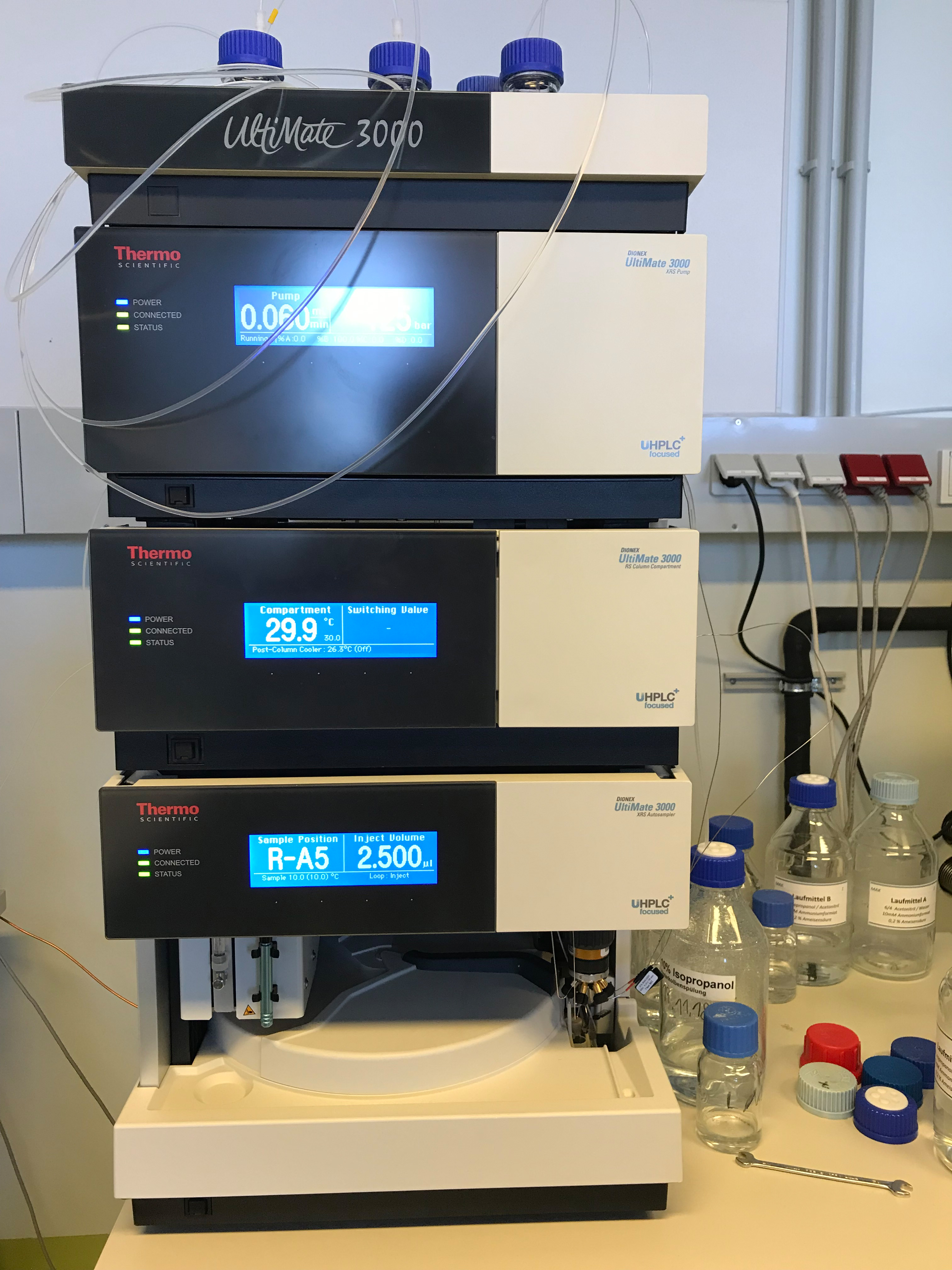HPLC
Equipment:
Various analytical and semipreparative HPLC systems: UltiMate 3000 UHPLC focused system (Thermo Scientific) and a HP 1100 Series system (Agilent) with DAD UV/Vis and Fluorescence detector. Vanquish Neo and UltiMate 3000 RSLCnano systems (Thermo Scientific) for nano-HPLC separations controlled through Chromeleon and SII software.
Methods:
Reversed-Phase High Pressure Liquid Chromatography (RP-HPLC):
Method: RP-HPLC is a powerful separation technique for proteins and peptides in general and suitable for the analytical as well as preparative scale. Besides speed and efficiency, this method is advantageous because of its great range of mobile and stationary phases.
Hydrophilic Interaction Liquid Chromatography (HILIC):
Method: The mode of chromatography utilizing hydrophilic interactions to separate solutes is referred to as normal phase chromatography. It is characterized by the use of polar stationary phases in combination with apolar eluents. Under typical HILIC conditions retention of solutes increases with increasing solute hydrophilicity and decreasing mobile phase polarity, a behavior that is just the opposite of that observed in RPC.
Ion Exchange Chromatography (IEC):
Method: Ion exchange chromatography separates proteins by charge primarily through electrostatic interactions between charged amino acid side chains and the surface charge of the ion-exchange material. Ion-exchange materials are generally water insoluble polymers containing cationic or anionic groups. Cation exchange matrices have anionic functional groups such as -SO3- and -COO- and anion exchange matrices usually contain the cationic tertiary and quaternary ammonium groups, with general formulae -NHR2+ and -NR3+. Proteins become bound by exchange with the associated counter-ions and are usually eluted by buffers with increasing salt concentrations.
Size Exclusion Chromatography (SEC):
Method: Size-exculsion chromatography, also called gel-filtration or gel-permeation chromatography (GPC), uses porous particles to separate molecules of different sizes. It is generally used to separate biological molecules, and to determine molecular weights and molecular weight distributions of polymers. Molecules that are smaller than the pore size can enter the particles and therefore have a longer path and longer residence time than larger molecules that cannot enter the particles.
Provided Services:
-
Separation of proteins and peptides: A full range of chromatography techniques are available including reversed-phase, ion exchange, size exclusion and hydrophilic interaction liquid chromatography.
-
Peptide mapping using reversed phase chromatography including the collection of the peptide fractions, if requested (e.g. for identification of peaks via N-terminal sequencing or MS).
-
Amino Acid Analysis: Amino acid analysis allows for amino acid quantitation of free amino acids, as well as amino acids released from macromolecules such as peptides, proteins or glycoproteins.
-
Polyamine Analysis (e.g. putrescine, spermidine, spermine, agmatine).
Separation of proteins based on chromatography often requires time-consuming, extensive method optimization including the application of various separation modes. For this reason these methods are not offered on a routine basis. Additional and detailed information is therefore required. Please contact us via “e-mail”.
Sample Preparation:
-
Samples can either be dissolved in water (best) or buffers with known composition, pH value etc.
-
Samples can also be lyophilized.
Providing as much information as possible on the sample submission form or if necessary on a separate sheet will help in selecting an appropriate separation strategy.
Fees for HPLC:
For further details and price, please contact us via “e-mail”
Sample submission form. Download "here".




